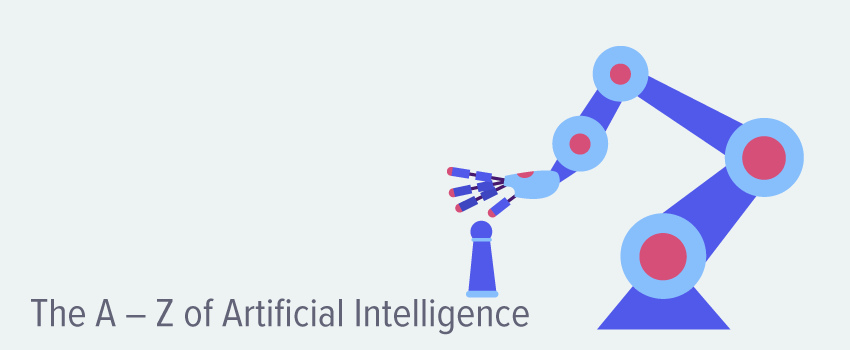
The A – Z of Artificial Intelligence (AI)
Artificial intelligence (AI) can be a complicated world to explore – with phrases like general AI and narrow AI, weak AI and strong AI, machine learning, and deep learning. It can become very complicated pretty quickly, and if you’re anything like me you probably need a lie down just after reading this introductory paragraph. Anyway…
To help you better understand the opportunities of AI, here’s my A – Z guide that will give you an introduction to what intelligent machines really are, why it’s become so popular within IT service management (ITSM) circles, and why it’s definitely not going to go away.
Let’s start with A (because, well… you know)…
Algorithms
Algorithms are sets of instructions written by humans, and used by machines, to complete tasks. The instructions are written in a programming language and need to be incredibly detailed – such that the instructions can tell the machine what to do and how to do it.
With AI, algorithms are now being developed to allow machines to learn for themselves (this is “machine learning” which you can learn about with the letter M below).
Brains
AI can kind of be described as “machines with brains.” Of course, they don’t actually have brains like humans (or puppets) and they can’t think for themselves, but the research and creation of AI is linked to the human brain.
Our brains (yes, mine too) are far more complex than any current AI in existence. And artificial neural networks (ANN) consist of thousands of neurons whereas our human neural networks have billions.
That said, AI is at a point now where it can complete certain tasks quicker, and more accurately, than any human – which is why it’s become popular in the ITSM world. Intelligent systems are taking over repetitive human tasks, which saves organizations time and money, and frees up people to work on more complex, and potentially more important, issues.
Cost Savings
Because the machines are taking on work that employees used to do, it means that organizations can save money on the total costs of IT service delivery and support. The machines can work 24/7, don’t go off sick or take vacations, and can tackle a much larger workload than any individual.
Deep Learning
Deep learning is a sub-field of machine learning – in that it’s like machine learning but more advanced. Machines require massive amounts of data to learn from and deep learning can take this further.
“AlphaGo” was developed by Google to play the game “Go” against professional players. With machine learning the program would have been able to play the game by looking at past games (of Go) and seeing how they were won, and then use this data to become a worthy challenger. With deep learning though, AlphaGo taught itself how to become the best player and went on to beat the world’s best Go players.
It made moves no human had ever thought to do before, and here we can really see the potential that deep learning brings. The DeepMind website says “AlphaGo somehow taught the world completely new knowledge about perhaps the most studied and contemplated game in history.”
Ethical Dilemmas
Ethics in AI covers multiple areas – it looks at the creation of safe machines (machines that will do humans no harm as their intelligence advances), it looks at the treatment of the machines themselves (at what point do they have moral status?), and it looks at our own rights (think of all the data AI needs in order to learn and what happens to our private data).
As AI continues to develop, these are just some of the ethical dilemmas that will need to be addressed with appropriate solutions worked out.
Fifties
The 1950s – this is when the term AI was first coined. Plus, the first machine to win a game of chess against a human happened in the late fifties and AI has “grown up” from there.
Humans have been studying AI for decades and now we’re beginning to reap the benefits.
General Artificial Intelligence
General AI (also known as strong AI) is at the far end of the AI spectrum – where AI could do anything you ask it to do and it could do it better than any human. This is where a lot of AI researchers want to get to but it’s an incredibly ambitious concept.
Remember AlphaGo from a moment ago? Yes, it’s incredible at playing Go but it couldn’t play anything else. It’s trained only in one specific task and that’s all any intelligent machine can do right now.
If we had made the move to general AI, then AlphaGo would be able to play any game, drive a car, and complete many of your ITSM tasks for you.
Will we ever get to this point? Who knows?
Human Protection
AI can be used to protect humans. We’re already using it to help detect diseases like cancer in its early stages.
For example, a company is currently working on a mobile phone app that can be used to photograph moles, it then compares your mole to millions of others (in the data it has) and can tell you (with great accuracy) whether or not it’s cancerous.
In ITSM we’re always being asked to “do more with less” which can be incredibly stressful. Thus, AI is a way of helping to take away some of that stress by completing previously manual tasks quickly and accurately.
IT Tools
AI is increasingly being used in the IT management tools employed by IT departments to help them become better at providing top-notch service delivery and support. In these secenarios, AI and automation are being used to:
- Speed up processes
- Get more done with less people effort and lower costs
- Analyze large data sets quickly and correctly, and
- Remove the siloes between teams, offering a more integrated environment.
Job Woes
All this talk of AI doing our work for us certainly sounds like there’ll be job losses in the near future. And, while it’s true that humans will no longer be needed for some tasks it’s also true that AI has the ability to create many jobs too.
In ITSM, AI can be used to enhance our roles and make us more productive. One example is for the IT service desk, where chatbots can be used to log tickets, thus freeing up service desk agents to tackle bigger issues.
Knowledge Base
A knowledge base is one of the best tools your IT department can have. And when you add AI capabilities in with your knowledge base the potential for progress is huge.
A “smart,” i.e. AI-enabled, knowledge base can give end users the information they need in seconds, log tickets for them, and even learn from end users’ previous issues to find answers to future incidents and expand on the information it stores.
Language Processing
It’s actually called Natural Language Processing (NLP) – but I had to be a bit creative because I needed a suitable word, or phrase, for L.
This is the part of AI that helps machines to understand language. For instance, virtual assistants like Amazon’s Alexa and Apple’s Siri use NLP to understand our requests.
The ultimate aim here is for AI to understand language as successfully as humans do – not just the words but also the context-based meaning of them.
Machine Learning
Machine learning is a sub-field of AI that learns from data. The more data the machine acquires, the more it learns, and thus machines can become smarter over time.
Imagine the smart knowledge base mentioned above – end users can search the knowledge base for answers to their queries and they can rate the information they’re given (you’ll probably have seen the “Did this article help you?”-type question yourself when searching the internet) – thus helping the machine to learn what’s working and what isn’t.
Over time the knowledge base will get smarter and show consistently-relevant articles as it learns what’s helpful for each question. This means that you’re empowering your end users and seeing fewer tickets logged to the IT service desk.
Narrow AI
Narrow AI (also known as weak AI) is the stage we’re at now with machine intelligence.
Whereas general AI essentially means the AI can do anything asked of it, narrow AI means that the machine can only do a specific task (or focused set of tasks). For instance, a self-driving car can drive itself because that’s the data it’s learned, and is learning, from. Ask that machine to log tickets on your IT service desk and it won’t know what to do!
Available AI technology is considered “narrow” because it cannot yet switch between disparate tasks.
One Goal
Currently intelligent machines have one goal. The self-driving car has a goal to drive from A to B. AlphaGo has a goal to win at Go. Your IT service desk virtual agent, if you have one, has a goal to provide end users with information about their incidents and requests.
As AI advances it’s possible that machines will be able to tackle multiple goals and operate more like humans – seamlessly switching between tasks.
Pattern Recognition
In the field of machine learning, one method machines use to learn is pattern recognition. When they’re sorting through the vast amounts of data they have access to, they determine the patterns within it, which in turn helps them learn what they need to achieve their goal.
Quality
AI helps to deliver quality work – in the world of ITSM you might be using AI to triage tickets, provide end users with the knowledge documentation they need to resolve their incident, or improve your IT department’s dashboards using AI analytics. You might even be using it to help find the root cause of IT problems within your organization.
Whatever AI is helping your organization with, you can be sure that the output is top quality, every single time (assuming that the technology has been implemented correctly). AI removes the risk of human error and speeds up your department’s work activities and flows.
Real-Time
Real-time AI systems will have a big impact on speeding up processes across multiple industries. For example, the existing process to run a background check can take around two weeks, using AI it can deliver real-time results in minutes.
AI will ultimately help to make unnecessary paperwork and manual processes a thing of the past.
Singularity
“The technological singularity” is the moment when machines become more intelligent than humans – a time when we can no longer understand how machines are doing what they do.
Whether we ever reach this moment is anybody’s guess, but some experts predict it’ll be here in about 30 years.
We’ve already seen machines beat world professionals at their own game (AlphaGo), mimic humans so well that when they talk on the phone we don’t know it’s a machine (Google Assistant), and even create their own language (Facebook’s AI experiments).
Is it really so hard to believe that we’ll get there?
Time Saving
By completing tasks far quicker than humans, AI has the power to save your organization a lot of time (and money).
AI will speed up your processes, remove the need to re-do work when human mistakes are made, and save your end users time by instantly providing them with the information they ask for.
Universal Exploration
Using AI, we can also explore the universe without risk to human life.
The Curiosity Mars Rover, currently trundling around Mars, has the ability to detect rocks that humans want to study and is able to find them on its own accord (i.e. it no longer needs to be in contact with humans telling it where to go).
This is just the beginning of AI in space, but hopefully you can imagine the possibilities.
Virtual Assistants
Virtual assistants can be used on your IT service desk to log tickets, triage tickets, answer FAQs, send updates to customers, and even close tickets when appropriate. All without the need for human intervention.
Worry
There’s a lot of worry around artificial intelligence – will there be excessive job losses? Will we develop killer robots? Will AI become smarter than humans? The truth is these questions are unanswerable and experts are split with their predictions.
It’s good to be worried, because that worry is what drives debates and encourages us to be cautious. It’s also important to look at what AI can do for us and how far we’ve already come because of it.
If one thing is for sure though, IT departments not utilizing AI – and their parent businesses – are certain to get left behind.
X-Rays
This has to be the go-to word for X when writing an A – Z list, right? I did wrack my brain for something else, but nothing came and, actually, this is a pretty cool example of how AI is helping us.
Just like the detection of cancer in moles example mentioned earlier, AI is helping radiologists too. It can be used to help doctors when they’re making a diagnosis by quickly checking a database full of thousands of x-ray images. This speeds up the diagnosis process and makes the practice more efficient – which can be vital when dealing with life-threatening illnesses.
The belief is that, at the moment, AI won’t replace radiologists – it will act as an assistant, speeding up the process and providing more certainty for difficult diagnoses.
Yin and Yang
For AI to be truly successful we’ll need to find a balance. Where, rather than machines and humans becoming opposing forces, they work to complement one another – yin and yang.
AI can assist humans to make us better and we can assist machines to help them achieve their goals in line with moral and ethical codes.
The risk of course is that the balance is upset – with humans pushing the limits to see what can be achieved without considering, or caring about, the consequences.
Zooming … (up tasks…)
Ok, it’s a massive stretch and we’ve already spoken quite a lot here about how AI can speed up your organization’s processes. But it can speed them up by such an order of magnitude that it’s really worth mentioning it several times. Plus, I have no clue what else to use for the letter Z.
If you’ve got a better idea for Z, or any of the other letters, I’d love to hear your thoughts in the comments.
And finally, if you liked this blog, here’s my earlier A – Zs of SIAM and enterprise service management.






